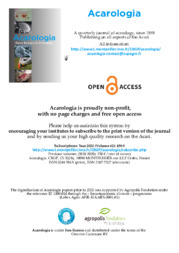New parasitism record of Pyemotes tritici (LaGreze-Fossat e Montagne, 1851) (Acari: Pyemotidae) on boll weevils inside cotton squares.
New parasitism record of Pyemotes tritici (LaGreze-Fossat e Montagne, 1851) (Acari: Pyemotidae) on boll weevils inside cotton squares.
Author(s): SILVA, C. A. D. da; MORAES, G. J. de; CASTILHO, R. C.; RAMALHO, F. S.; LIMA, T. A.
Summary: Mites of the family Pyemotidae are reported as ectoparasites of a large number of arthropods He et al., 2019; Sousa et al., 2020; Chen et al. 2021), mainly insects of the orders Lepidoptera (Cunha et al., 2006; Oliveira et al., 2007; He et al. 2012, 2014; Liu et al, 2020; Tian et al. 2020), Hemiptera (Han, 2016; Li et al. 2019; Yu et al. 2019), and Coleoptera (Cunha et al. 2006; Guo et al. 2009; Oliveira et al., 2010). Pyemotes spp., also known as ?straw itch mites?, are of particular interest in applied acarology, both for their behavior as insect parasites and for their medical importance (Tomczyk-Socha et al. 2017; He et al., 2019). Adult females of this mite attach themselves to the host to feed, undergoing physogastry, the expansion of the posterior portion of their body (opisthosoma) to facilitate offspring development (Cunha et al. 2006). According to Tomalski et al. (1988), approximately 200 to 350 sexually mature mites are produced per female. Males are the first to be born, as adults, immediately copulating with their adult sisters. The newborn females immediately seek new hosts, which once parasitized, become paralyzed by the release of toxins (Sousa et al., 2020). Neurotoxins from a single female are sufficient to paralyze an insect host up to 150,000 times the size of the mite (Mullen and Oconnor, 2019). Studies on the potential of Pyemotes zhonghuajia as a biological control agent for eggs, larvae and pupae of the fall armyworm Spodoptera frugiperda (Smith) (Lepidoptera: Noctuidae) and the oriental armyworm Mythimna separata (Walker) (Lepidoptera: Noctuidae) demonstrated that a female is capable of killing more than 50% of first to third instar larvae of S. frugiperda and M. separata within 72 h under laboratory conditions (Liu et al., 2020; Tian et al., 2020).
Publication year: 2022
Types of publication: Journal article
Unit: Embrapa Cotton
Keywords: Algodão, Anthonomus Grandis, Anthonomus grandis grandis, Artrópodes, Cotton, Dust mites, Parasitism, Parasitismo, Toxin, Toxina, Ácaro, Ácaro da palha
Observation
Some of Embrapa's publications are published as ePub files. To read them, use or download one of the following free software options to your computer or mobile device. Android: Google Play Books; IOS: iBooks; Windows and Linux: Calibre.
Access other publications
Access the Agricultural Research Database (BDPA) to consult Embrapa's full library collection and records.
Visit Embrapa Bookstore to purchase books and other publications sold by Embrapa.

